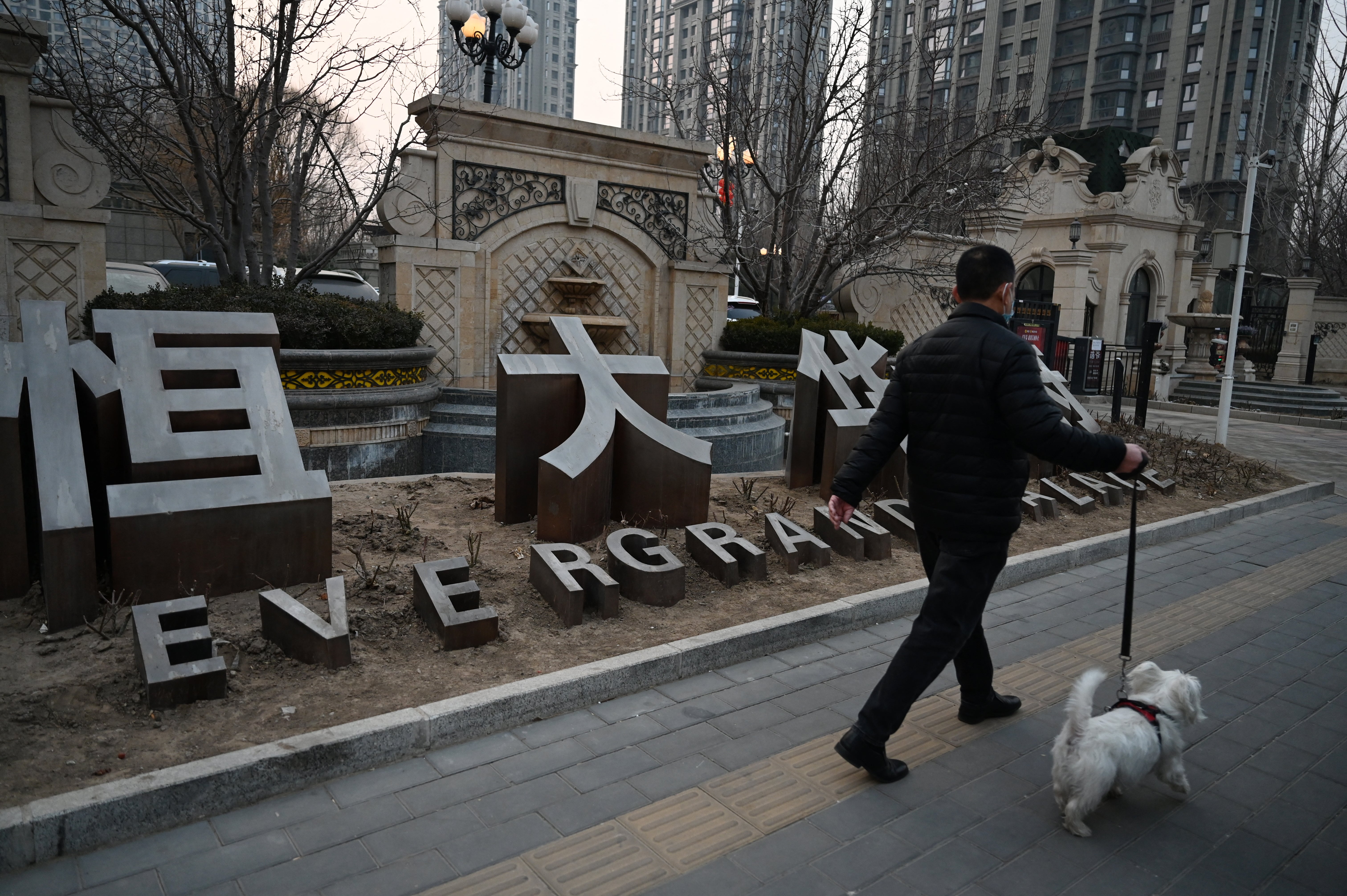Business
How the fall of Evergrande spells doom for China’s property market

The shares of China’s most indebted property giant Evergrande have been taken off the Hong Kong stock market, marking the end of its life as a publicly traded company that symbolised the rise and fall of China’s real estate industry.
Valued at more than $50 billion (£37.1bn) at its peak, Evergrande was China’s biggest property firm. But it became the poster-child for the problems facing Chinese developers after it collapsed under the weight of massive debts in 2021.
“Evergrande’s demise highlights that no private company in China is too big to fail,” Julian Evans-Pritchard, Head of China Economics at Capital Economics told The Independent.
“But the fact that it has taken this long for the company to be delisted underscores the slow-motion nature of China’s property adjustment, with state intervention preventing a more abrupt resolution.”
Evergrande’s 2021 default on offshore bonds led to its shares being suspended in January 2024, after a Hong Kong court ordered liquidation when years of restructuring talks failed.
Last week, the stock exchange confirmed it would cancel the listing because the firm failed to meet the requirement to resume trading within 18 months.
It comes as China’s economy is grappling with a series of challenges, including Trump’s tariffs, weak consumer spending, unemployment, high local government debt and an ageing population.
Experts say the collapse of the property sector has hit the country hardest, as it accounted for roughly a third of China’s economy and provided crucial revenue for local governments.
“It is a symbolic moment given that Evergrande was the first major casualty of China’s property downturn,” Mr Evans-Pritchard said. “The delisting itself won’t have a big impact given that the company’s market capitalisation had already collapsed and trading in the stock was suspended last year.”
“Although the company is being wound down, work on its projects is generally still ongoing, with local governments stepping in to make sure buyers eventually get the homes they bought.”
The company’s fall was as dramatic as its rise. Its founder, Hui Ka Yan, went from living a humble rural life to becoming one of Asia’s richest men.
Evergrande’s growth reflected the debt-fuelled nature of China’s property sector, which expanded rapidly following urbanisation and economic reforms in the 1990s.
Its 2009 listing marked a pivotal moment in that surge, with the company borrowing an unprecedented $20bn on international bond markets.
But the $45bn fortune that put Mr Hui at the top of the Forbes list of wealthiest men in Asia plummeted to less than $1bn.
By March 2024, Mr Hui was banned from China’s capital market for life over Evergrande’s overstating of its revenue by $78bn and he was fined $6.5m.
At the time of its collapse, Evergrande had an empire of 1,300 projects under development across 280 cities, an electric car business and Guangzhou FC. Earlier this year, China’s most successful team was itself kicked out of the football league due to debt.

Built on more than $300bn of borrowed money, Evergrande struggled to meet interest payments after Beijing introduced borrowing limits for developers in 2020.
Deep discounts on properties failed to prevent defaults on overseas debt, ultimately triggering liquidation.
The crisis wiped more than 99 percent from it stock market valuation.
Earlier this month, liquidators Alvarez & Marsal said they have so far recovered just $255m of assets, including a Claude Monet painting, out of the $45bn debt.
They also launched action against the firm’s auditors PwC China after authorities last March said it approved accounts despite inflated revenues in 2019 and 2020.
The housing crisis in China is far from over, with property firms like Country Garden still battling massive debt. Earlier this month China South City Holdings became the largest developer to be forced into liquidation since Evergrande.
“We think the property downturn is likely to continue for at least a couple more years, given that it will take time for the market to fully absorb excess supply as the backlog of unfinished projects are completed,” added Mr Evans-Pritchard.
Beijing launched a range of measures to revive the housing market and consumer spending, including incentives for new homeowners, stock market support, and purchases of electric cars and household goods.
Despite these efforts, China’s growth has slowed to around 5 percent, about half the rates seen in 2010.
Business
CII Lays Out Investment Roadmap For Budget 2026-27

India’s next phase of economic growth will depend on steady and strong investment across public, private, and foreign channels, according to the Confederation of Indian Industry (CII). CII, in a release, laid out a detailed plan for the Union Budget 2026-27, saying that the Budget needs to act as both a stabiliser and a growth driver.
CII Director General Chandrajit Banerjee said the coming Budget must focus on boosting investments to keep India’s growth steady. He explained that public spending has pushed the country’s recovery after the pandemic, and that continued support in this area will help India stay on track as one of the fastest-growing major economies.
CII has suggested raising central capital expenditure by 12 per cent and increasing support to states by 10 per cent in FY27. These funds, it said, should go mainly to areas where spending creates the highest impact, such as transport, energy, logistics, and the green transition. CII also recommended creating a Capital Expenditure Efficiency Framework to help select and track important projects and measure their outcomes more clearly. Along with this, it proposed launching a new Rs 150 lakh crore National Infrastructure Pipeline for 2026-32 to give long-term clarity to investors and states.
The release also noted that India needs a more flexible fiscal policy. CII suggested shifting from strict annual deficit rules to a debt framework that adjusts with economic cycles. This, it said, would help the government respond better during shocks without losing long-term stability.
On private investment, CII highlighted that India now needs strong momentum from businesses to support growth. “The Government of India has provided a big demand push via income tax relief in last year’s Union Budget and recently via GST 2.0. Investments, especially private sector investment, will be the next big driver for economic growth that needs to be focused on in the next fiscal to continue the growth momentum,” Banerjee said.
CII recommended tax credits or easier compliance for companies that increase investments or production, along with returning accelerated depreciation to help firms, especially MSMEs, modernise.
To attract long-term global capital, CII proposed creating an NRI Investment Promotion Fund with partial government holding. This fund would help channel NRI and foreign institutional money into areas like infrastructure and AI. It also suggested strengthening the National Investment and Infrastructure Fund through a new Sovereign Investment Strategy Council to guide investments.
CII further called for simpler external borrowing rules and a single-window system for large foreign investment proposals to reduce delays and increase certainty. It also suggested forming an India Global Economic Forum to allow structured discussions between global investors and government leaders.
“An investment-driven growth strategy, anchored in fiscal credibility and institutional reforms, will define India’s next development phase,” Banerjee said.
Business
Investment focus: CII pitches reforms for Budget 2026-27; industry body seeks capex push – The Times of India

The Confederation of Indian Industry (CII) has urged the Centre to adopt a wide-ranging set of reforms in the Union Budget 2026-27 to reinforce India’s investment-led growth cycle and sustain its position as one of the world’s fastest-expanding major economies, PTI reported.In a detailed submission for the upcoming Budget, CII recommended raising central capital expenditure by 12% and increasing capex support to states by 10% in FY27, launching a Rs 150 lakh crore National Infrastructure Pipeline (NIP) 2.0 for 2026-32, and introducing incremental tax credits or compliance relaxations for companies achieving notable milestones in investment, output or tax contribution. The industry body also sought an NRI Investment Promotion Fund and the reinstatement of accelerated depreciation benefits to spur fresh capital expenditure, especially for MSMEs and manufacturing sectors, without triggering Minimum Alternate Tax (MAT) liability.CII said strengthening the National Investment and Infrastructure Fund (NIIF) through a proposed Sovereign Investment Strategy Council (SIFC) would help align investments with national economic priorities. The Union Budget for FY27 is scheduled to be presented on February 1.According to the industry chamber, replacing rigid annual fiscal-deficit rules with an economic-cycle-based public debt framework would bolster resilience and allow counter-cyclical flexibility during global shocks, while ensuring the credibility of medium-term debt sustainability.“The forthcoming Union Budget 2026-27 has to serve the dual role of stabiliser and growth enabler, and promoting investments will be one of the most critical components in this regard,” said CII Director General Chandrajit Banerjee.He added that CII’s proposals centre on fiscal prudence, capital efficiency and building investor confidence.CII stressed that public capex has been the backbone of India’s post-pandemic recovery, crowding in private investment. To improve execution, it suggested creating a Capital Expenditure Efficiency Framework (CEEF) for selecting high-impact projects and monitoring outcomes based on productivity and regional growth spillovers.The chamber said facilitating private and foreign investment will be essential in driving the next phase of expansion. It proposed tax incentives linked to new investment and production milestones in high-growth areas such as clean energy, electronics, semiconductors and logistics. It also suggested the creation of an NRI Investment Promotion Fund — a government-private entity with up to 49% government stake — to mobilise overseas and institutional capital into infrastructure and emerging sectors.Further, easing external commercial borrowing norms with higher limits, longer tenures and partial risk cover for infrastructure and manufacturing projects would improve access to foreign capital, CII said. A single-window clearance system with deemed approval within 60-90 days for large FDI proposals was also recommended to accelerate big-ticket investment decisions.To deepen engagement with global investors, CII proposed an India Global Economic Forum — a government-led platform bringing together sovereign wealth funds, pension funds, private equity firms and multinational corporations for structured dialogue with senior policymakers.“An investment-driven growth strategy, anchored in fiscal credibility and institutional reforms, will define India’s next development phase,” Banerjee said.
Business
Wealth outlook: India set for multi-trillion-dollar expansion; MoSL sees $12 trillion value boost ahead – The Times of India

India is poised to enter a decisive phase of economic expansion that could redefine long-term wealth creation, according to Motilal Oswal Financial Services’ 30th Wealth Creation Study, which projects a sharp acceleration in the country’s economic and consumption landscape over the next 17 years, ANI reported.The study draws a parallel with the last growth cycle, when India’s GDP expanded fourfold from $1 trillion in 2008 to $4 trillion in 2025, and says a similar trajectory could take the economy to $16 trillion by 2042. Unlike the previous phase, which added $3 trillion in absolute GDP, the next leg is expected to add $12 trillion, signalling what the brokerage terms a much stronger wealth-effect that could significantly lift consumption, investment and corporate profitability.A major pillar of this expansion is expected to be the financial services ecosystem, with cumulative household savings estimated at $47 trillion over the period. Banks, NBFCs, insurers, AMCs, wealth managers, capital market platforms and other intermediaries are expected to play a central role in channelling these savings into productive financial assets as households move further towards formal wealth creation avenues.Per capita income, currently around $2,600, is projected to quadruple to $10,400 by 2042, pushing millions of Indians into higher consumption brackets. The study says this transition will strengthen discretionary categories including white goods, food-tech platforms, quick commerce, healthcare, travel, telecom and allied services, accelerating the shift from necessity spending to lifestyle-driven consumption.On automobiles, MoSL highlights significant headroom for growth. Penetration levels of cars, SUVs, two-wheelers and three-wheelers remain well below those of peer economies with similar income levels. As affordability improves and financing deepens, ownership ratios are expected to rise across cities and semi-urban markets.Real estate is also set to be a key beneficiary, with strong demand expected for credible developers, particularly in the premium and luxury segments. Rising household wealth, better affordability and higher preference for quality housing are likely to sustain sectoral momentum.Overall, the study notes that the next 17 years could mark a step-change in India’s economic and wealth trajectory. With expansion taking place on a much larger base, the impact of the wealth-effect is expected to be far deeper than previous cycles, creating long-term opportunities across financial services, consumption-led industries, automobiles and real estate.
-

 Politics7 days ago
Politics7 days agoThailand launches air strikes against Cambodian military: army
-

 Politics7 days ago
Politics7 days agoZelenskiy says Ukraine’s peace talks with US constructive but not easy
-

 Tech1 week ago
Tech1 week agoWIRED Roundup: DOGE Isn’t Dead, Facebook Dating Is Real, and Amazon’s AI Ambitions
-

 Politics1 week ago
Politics1 week ago17 found dead in migrant vessel off Crete: coastguard
-

 Fashion6 days ago
Fashion6 days agoGermany’s LuxExperience appoints Francis Belin as new CEO of Mytheresa
-

 Business1 week ago
Business1 week agoNetflix to buy Warner Bros. film and streaming assets in $72 billion deal
-

 Politics4 days ago
Politics4 days agoTrump launches gold card programme for expedited visas with a $1m price tag
-

 Tech5 days ago
Tech5 days agoJennifer Lewis ScD ’91: “Can we make tissues that are made from you, for you?”





